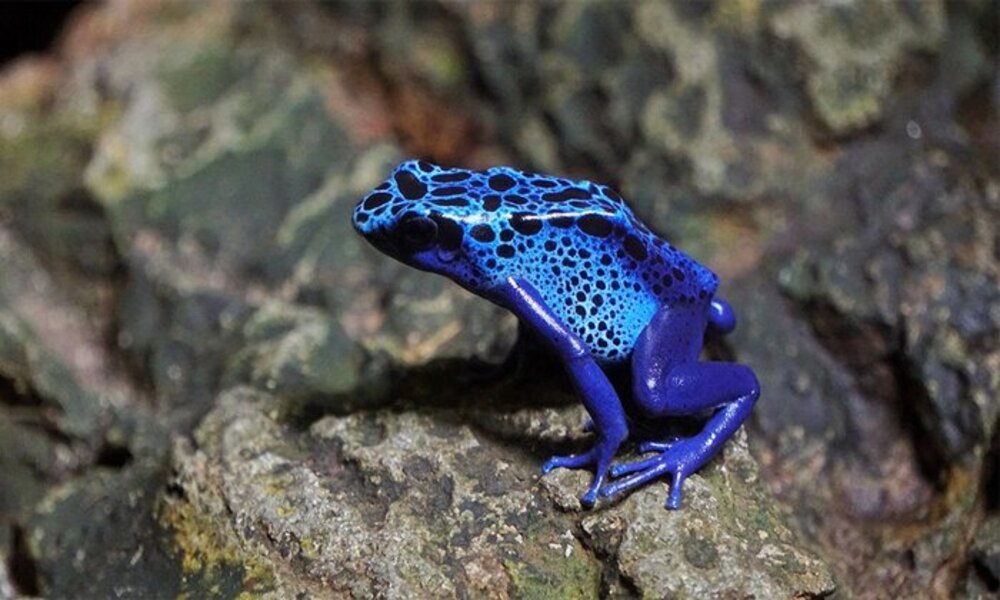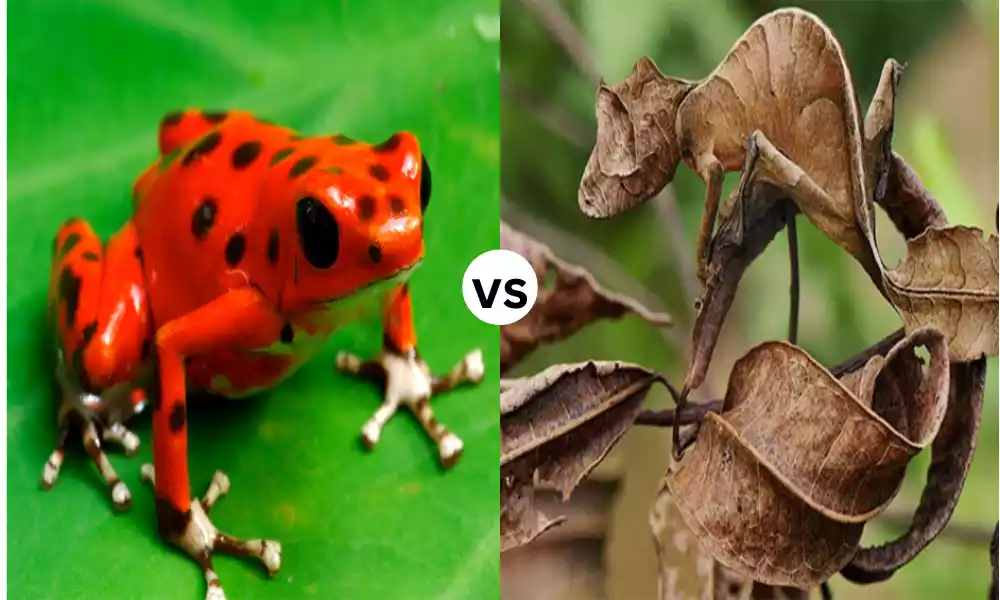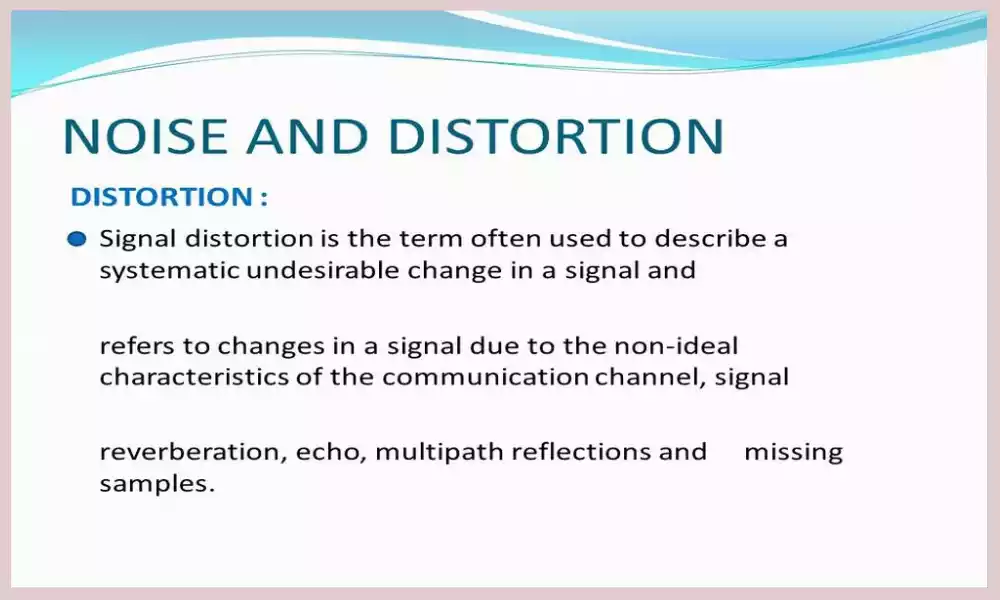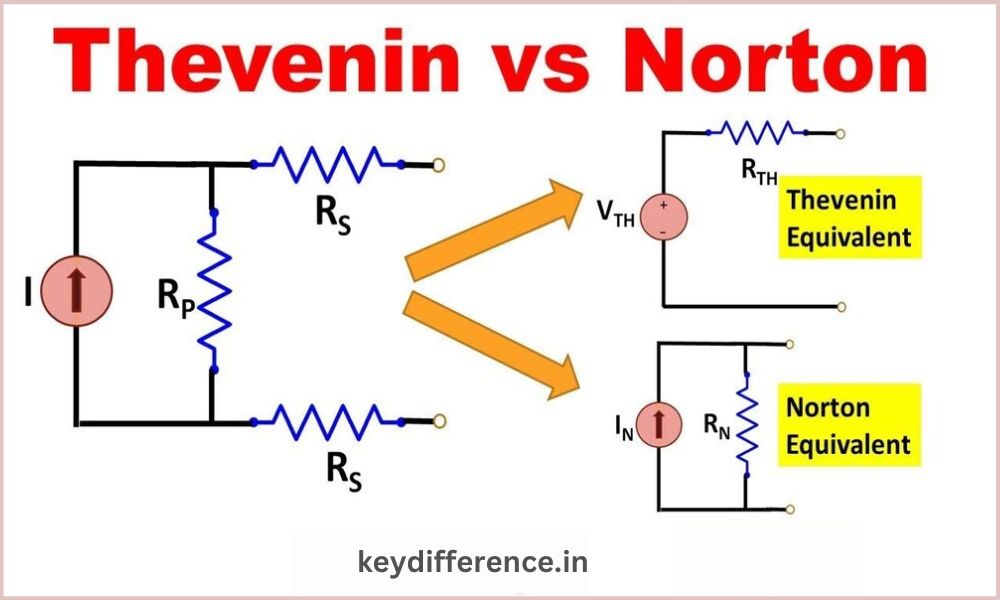Introduction
Coloration in animals serves a number of functions, such as communication, camouflage and defense. Apsematic and cryptic colorations play significant roles in survival and interactions among organisms respectively.
Aposematic coloration refers to the use of distinctive and conspicuous color patterns by animals as a warning signal against potential predators. These vibrant hues serve as visual advertisements, signaling that there may be toxic substances, venom or other defense mechanisms present that could cause harm or death; by making themselves known with this form of display they reduce predator attacks while lessening chances of being eaten or attacked themselves.
Contrastingly, cryptic coloration – also referred to as camouflage – involves colors and adaptations designed to blend in seamlessly with their environment, such as mimicking its background colors. Cryptic hues enable organisms to remain visually indistinguishable from their environment in order to evade detection by predators or increase chances of ambushing prey successfully.
Understanding the differences between aposematic and cryptic coloration is integral to understanding the intriguing adaptations and survival strategies employed by various organisms. We will examine both types in more depth in future sections, exploring their characteristics, examples in nature, evolutionary significance, implications on predator-prey interactions and implications on predator-prey interactions. By investigating different coloration strategies employed by animals to adapt to their environments for survival we gain invaluable insights.
What is Aposematic Coloration?
Aposematic coloration refers to the vibrant and conspicuous patterns displayed by certain animals to warn off potential predators. These vivid hues often include bright hues such as red, yellow, orange, black and white that serve to advertise chemical defense mechanisms or toxicities present within an organism as deterrents against potential predators.
The purpose of aposematic coloring is to advertise these defense mechanisms or toxicities that exist and act as deterrents for predators. Animals exhibiting aposematic coloration often possess toxic or otherwise dangerous substances that could cause pain, sickness or even death if consumed or attacked.
By advertising their unpalatability or danger via vibrant coloration they hope to educate predators against preying upon them and discourage predation attempts from occurring. Such animals can be found among various animal groups like insects, amphibians, reptiles and birds as well as mammals.
Effective aposematic coloration relies on creating an association between warning colors and the unpleasant experiences predators have had with these species in the past.
By repeatedly encountering similarly colored organisms, predators learn to associate conspicuous color patterns with negative consequences associated with attacking or eating them – creating an impactful lasting impression, prompting them to avoid similar ones in future encounters.

What is Cryptic Coloration?
Cryptic coloration, commonly referred to as camouflage, allows organisms to blend into their environments more successfully so as not to attract predators or prey that could otherwise detect them. Cryptic coloring enables animals to visually blend with their environment more successfully thereby increasing their chances of survival through camouflaging themselves successfully in this way.
Cryptic coloration serves two primary goals, either to avoid detection by predators or increase chances of successful prey capture. It can be observed in various organisms including insects, reptiles, birds, mammals and marine life.
Cryptic coloring can be achieved through various adaptations that closely resemble its environment – for instance foliage, bark, rocks or coral reefs – including color patterns, textures and body shapes that closely resemble these features.
Effective cryptic coloration occurs when an organism can adapt its hues to match those of its surroundings, making it harder for predators or prey to visually recognize it from its surroundings.
Camouflage provides significant advantages by decreasing detection risk; staying hidden allows an organism to either avoid predation, or increase chances of ambushing unsuspecting prey without risk of detection.
Cryptic coloration may also include additional adaptations, such as disruptive coloring – where patterns or markings on an organism’s body disrupt its outline and make it harder to recognize – or masquerade, where an organism mimics inedible objects in its environment to avoid predation.
Overall, cryptic coloration plays an integral part in predator-prey interactions and survival strategies, enabling organisms to conceal themselves effectively within their respective habitats and increase the odds of their survival.

Comparison Table of Aposematic and Cryptic Coloration
Sure! Here’s a comparison table highlighting the key differences between aposematic and cryptic coloration:
| Accept | Aposematic Coloration | Cryptic Coloration |
|---|---|---|
| Definition | Vibrant and conspicuous color patterns that serve as a warning signal to potential predators | Color patterns and adaptations that allow an organism to blend into its environment, providing camouflage |
| Purpose | Deter predators by advertising toxicity or harm | Avoid detection by predators or increase chances of successful prey capture |
| Coloration | Bright and contrasting colors, often with combinations of red, yellow, orange, black, and white | Resembles the surrounding environment, matching colors, patterns, or textures |
| Evolutionary Significance | Associated with the presence of toxins or defensive mechanisms | Adaptation for avoiding predation or enhancing hunting success |
| Predator Response | Predators learn to associate the conspicuous colors with negative experiences and avoid attacking or consuming such organisms | Predators have difficulty visually detecting the cryptically colored organism, reducing the likelihood of detection |
| Examples | Poison dart frogs, coral snakes, monarch butterflies | Chameleons, stick insects, Arctic hares |
| Adaptations | Toxicity, venom, or defensive mechanisms paired with warning colors | Camouflage through matching coloration, disruptive patterns, or resemblance to inanimate objects |
| Habitat | Can be found in a variety of habitats, often in open spaces | Commonly observed in environments with diverse backgrounds, such as forests, deserts, or ocean floors |
| Visual Effect | Conspicuous and eye-catching, intended to draw attention | Blend seamlessly with the surroundings, making the organism difficult to distinguish |
This table provides a concise overview of the main differences between aposematic and cryptic coloration.
However, it’s important to note that some organisms may exhibit a combination of both strategies or may employ different coloration strategies depending on their life stages or environmental conditions.
Evolutionary theories and hypotheses related to aposematic coloration
Evolutionary theories and hypotheses have been put forth to explain the development and persistence of aposematic coloration among different organisms. Here are a few notable theories/hypotheses related to aposematic coloring:
Mullerian Mimicry: Proposed by Fritz Muller, this theory proposes that unrelated species with similar warning colorations converge over time due to mutual benefits. Under Mullerian mimicry, multiple species with aposematic coloration share similar warning signals, increasing predator learning efficiency by sharing these warning signals among multiple predatory animals and species with similar colorations – for instance when predators encounter some individuals from one species, learn to avoid them, then generalize this behavior against similar colorations species reducing risks for all involved parties involved.
Batesian Mimicry: First proposed by Henry Walter Bates, this theory describes a phenomenon in which harmless or palatable species mimicking highly toxic or unpalatable ones mimics warning colorations to deter potential predators. Mimics benefit by being mistaken as dangerous organisms which deters potential predators. This hypothesis rests upon predators learning to avoid one model species while providing a selective advantage for any replicating it in some way.
Aversion Learning: According to this hypothesis, predators may have an innate aversion toward certain color patterns due to their association with unpalatable or harmful prey. Over time through aversion learning, predators associate specific colors with negative experiences, leading them to avoid similarly colored organisms in general – suggesting that aposematic coloration has arisen as a result of predators’ innate dislikes for them. This theory further implies that aposematic colors have evolved as a result of predators’ innate dislikes for them innate aversions rather than by natural selection alone.
Honest Signaling: According to this hypothesis, aposematic coloration serves as an honest signal of an organism’s defenses or toxicity. By showing conspicuous colors that communicate their unprofitability or danger to potential predators, animals signaling unprofitability or danger as early as possible in attacks or consumption by predators. Furthermore, intensity correlates directly with potency of defense mechanisms used against an organism so predators accurately gauge risk associated with attacking or eating it.
Sensory Exploitation: According to this theory, aposematic coloration takes advantage of existing predator sensory biases or preexisting visual systems, evolving organisms to exploit predator’s preferences or aversions so as to make their warning signals highly detectable and memorable. According to this hypothesis, evolution of aposematic coloration is heavily influenced by these perceptual biases in predators.
Theories and hypotheses provide different views of the evolutionary processes underlying aposematic coloration development in various species. It’s important to keep in mind that these theories do not mutually exclude one another, as multiple factors may contribute to its evolution and diversity in nature.
Significance of warning signals in aposematic coloration
Warning signals in aposematic coloration play an integral role in the survival and interactions among organisms. Here are a few key significances of warning signals in aposematic coloration:
Predator Deterrence: Aposematic coloration acts as an important visual warning system, alerting potential predators of the presence of toxins, venom or other defensive mechanisms that could pose harm or deter attacks by predators. By showing their unpalatability or harm with vibrant hues and vivid patterns, organisms communicate this risk effectively to predators who would otherwise attack or consume them; their warning signals become associated with unpleasant experiences for these predators, decreasing future attacks against their target organisms.
Increased Survival: Aposematic coloration enhances an organism’s chances of survival by decreasing predation risk. By effectively publicizing their defense mechanisms through warning signals, organisms with aposematic colorations deter predators from engaging in costly or harmful interactions; this survival advantage allows aposematic species to persist and flourish in their respective environments.
Learning Efficiency: Aposematic coloration aids predator recognition. Once predators experience the consequences of attacking or eating organisms with such colorations, they quickly associate its warning signals with its unprofitability or danger; allowing them to quickly recognize and avoid similar colored organisms in future, saving time and energy on unsuccessful predation attempts.
Inter-species Signaling: Aposematic coloration can enable different species to collectively benefit through Mullerian mimicry. Unrelated species with similar warning colorations converge over time, increasing predator learning efficiency. By sharing similar warning signals multiple species reinforce each other’s learned aversion for predators while offering mutual protection and reducing negative encounters required for education of predators.
Honest Signaling: Warning signals in aposematic coloration serve as an honest signal of an organism’s defenses or toxicity, with intensity and conspicuity of its coloration indicating potency of its defensive mechanisms. Predators quickly learn that stronger warning signals indicate greater levels of risk associated with attacking or eating an aposematic species.
Coevolutionary Dynamics: Aposematic coloration can play a critical role in coevolutionary interactions between predators and prey species. As predators adapt their tactics to overcome or tolerate the defenses of aposematic species, their prey species may respond by intensifying or altering warning signals of their own to increase or decrease protection against their defenses; leading to an ongoing arms race between these species that shapes its evolution and diversification over time.
Conclusion Warning signals in aposematic coloration can play an integral part in deterring predators, increasing survival, facilitating predator learning and driving coevolutionary dynamics. Furthermore, visual communication plays an essential role in predator-prey interactions as well as ecological dynamics among multiple organisms.
Adaptations and strategies for achieving cryptic coloration
Cryptic coloration, also known as camouflage, involves various adaptations and strategies that enable organisms to blend in seamlessly with their surroundings and remain unnoticed. Below are some strategies commonly employed for achieving cryptic coloring:
Color Matching: Organisms with cryptic colors often exhibit colors that closely resemble their surroundings, making it hard for predators and prey alike to detect them visually. Their colors might match foliage, bark, rocks, sand or any other environmental elements in their immediate area.
Disruptive Coloration: Disruptive coloration refers to patterns or markings on an organism’s body which create visual distractions or break its outline, making it harder for predators to identify its shape or form as its body outline is interrupted by disruptive patterns such as stripes, spots or mottled patterns – providing more cover among complex backgrounds than regular coloring would.Some organisms have evolved adaptations that enable them to mimic the surface characteristics of their environment by imitating leaves, tree bark or other elements found within their habitat – this allows them to blend in more effectively while remaining undetected. This strategy involves having body textures or scales which closely resemble these features of nature in order to successfully blend in more seamlessly and remain undetected.
Counter-shading: Counter-shading is a form of coloration where an organism adopts darker coloring on its dorsal (upper) surface while lighter hues on the ventral (lower) surface, to counteract overhead lighting effects by appearing more evenly illuminated while decreasing shadows and therefore providing camouflage that helps break up body outline and make organism less conspicuous.
Shape and Body Posture: Some organisms exhibit body shapes or postures that mimic their surroundings, like stick insects which possess long bodies with flattened legs that resemble branches to blend in with their environment. Furthermore, certain butterfly species boast wings shaped to mimic leaves to further assist with camouflage.
Behavioral Adaptations: Alongside physical adaptations, behavioral strategies may also aid cryptic coloration. Organisms may exhibit specific behaviors to remain concealed such as freezing in place, swaying gently with nearby vegetation or adopting body postures that enhance camouflage. Such strategies help them avoid moving which might draw unwanted attention while increasing chances of remaining undetected.
Not to be overlooked is that cryptic coloration depends on its specific environment for its effectiveness, with different environments necessitating different adaptations and strategies for successful camouflage. With these adaptations in place, organisms with cryptic colorations can avoid detection while improving survival chances while remaining invisible to predators and prey alike.
Relationship to predator-prey interactions
Cryptic coloration, otherwise known as camouflage, plays an essential part in predator-prey interactions. The relationship between cryptic colouring and predator-prey interactions can be broken down into four key aspects:
Predator Detection: Cryptic coloration can help prey species avoid predator detection by blending into their surroundings. By closely matching colors, patterns, and textures in their environment, cryptically colored organisms become indistinguishable from one another and reduces their likelihood of detection from predators, increasing chances of survival.
Predator Avoidance: Cryptic coloration provides prey species a way to avoid predation by making it hard for predators to detect them visually and recognize them as potential prey. Cryptic camouflage disrupts their body outline, making it harder for predators to detect as potential prey; therefore reducing their chances of successfully capturing or attacking these organisms.
Ambush and Stealth: Cryptic coloration allows predators to ambush prey efficiently by blending in to their environment and remaining concealed until it’s time. Predators with such camouflage have an advantage in ambushing prey from behind by remaining undetected, increasing chances of surprise attacks and successful predation – exploiting element of surprise for maximum hunting success.
Prey Survival Strategies: Prey species have evolved various adaptations and behaviors besides their cryptic coloring to increase their chances of survival. For instance, some prey may engage in freeze behavior when approached by predators, remaining perfectly still until undetected by camouflage; other may engage in active camouflage by adapting their coloring according to changes in environments or adopting specific body postures to conceal themselves more effectively.
Evolutionary Arms Race: The relationship between cryptic coloration and predator-prey interactions is dynamic and often involves an evolutionary arms race. Predators exert selective pressure on prey individuals with better camouflage and cryptic coloration while prey species adapt in response to predators to reduce susceptibility. Over generations this coevolutionary process continues to refine cryptic coloration strategies as well as predator detection methods.
Cryptic coloration plays an integral part in predator-prey interactions by aiding predator avoidance, providing ambush opportunities, and aiding prey survival strategies. Cryptic coloring influences predator-prey balance while simultaneously shaping evolutionary dynamics and ecological interactions across various ecosystems.
Factors influencing the prevalence of aposematic and cryptic coloration
The prevalence of aposematic and cryptic coloration among organisms can be affected by many different factors. These elements play a part in shaping their evolution and distribution across species and habitats.
Here are a few key influences on their presence:
Predation Pressure: Predation pressure plays a key role in determining both aposematic and cryptic coloration preferences, particularly where predators are abundant and actively hunting for prey. Aposematic coloration may be more prevalent as an effective deterrent against predation in these environments, while lower predation pressure environments may benefit more from undetected colorations techniques that remain undetected by predators.
Toxicity or Defensibility: The presence and effectiveness of toxins, venom or other defensive mechanisms can influence the prevalence of aposematic coloration. Organisms possessing strong defenses are more likely to use their colors as an advertisement of unpalatability or danger; conversely species without strong defenses may rely more heavily on cryptic coloration to avoid detection and reduce predation risk.
Learning Abilities of Predators: Predator learning abilities and adaptability have an effect on their color patterns, such as the prevalence of aposematic coloration. If predators can learn and form associations between bright hues and negative experiences, aposematic coloration may be an effective strategy; otherwise cryptic coloration might become more prominent as a means to evade detection.
Habitat Characteristics: Habitat characteristics such as varied backgrounds, vegetation types and lighting conditions all influence whether or not cryptic coloration occurs in an environment. Complex or varied backgrounds provide more opportunities for effective camouflage making cryptic coloration more beneficial, while open environments with few hiding places may promote more rapid predator avoidance via aposematic coloration.
Coevolutionary Interactions: Interactions between predators and prey can alter their respective patterns of coloration; coevolutionary arms races between predators and prey can have profound ramifications on this front, altering both aposematic and cryptic colorations strategies in terms of prevalence over time.
When predators develop more effective detection mechanisms or strategies to overcome cryptic coloration strategies used by their prey, prey may respond with more effective aposematic hues as predators create detection mechanisms or strategies against them;
while predators create better strategies against it while prey may adopt more effective aposematic hues or strategies; this dynamic interplay can result in fluctuations between species as prey respond and predators/predators relationships can have profound consequences that affect coloration strategies used over time.
Ecological Context: Ecological factors, including interspecies interactions, competition for resources and resource availability can impact the prevalence and adaptive value of aposematic and cryptic coloring strategies in an ecosystem.
Factors like interspecies mimicry, multiple species displaying similar coloring strategies within an ecosystem or the availability of alternative prey can all have an effect on adaptive value and prevalence of coloration strategies like these.
Noting the variable prevalence of aposematic and cryptic coloration among species within an ecosystem, reflecting its complex interplay of factors and different ecological niches occupied by organisms. Together these elements determine adaptive value and frequency of such colorations across organisms and habitats.







